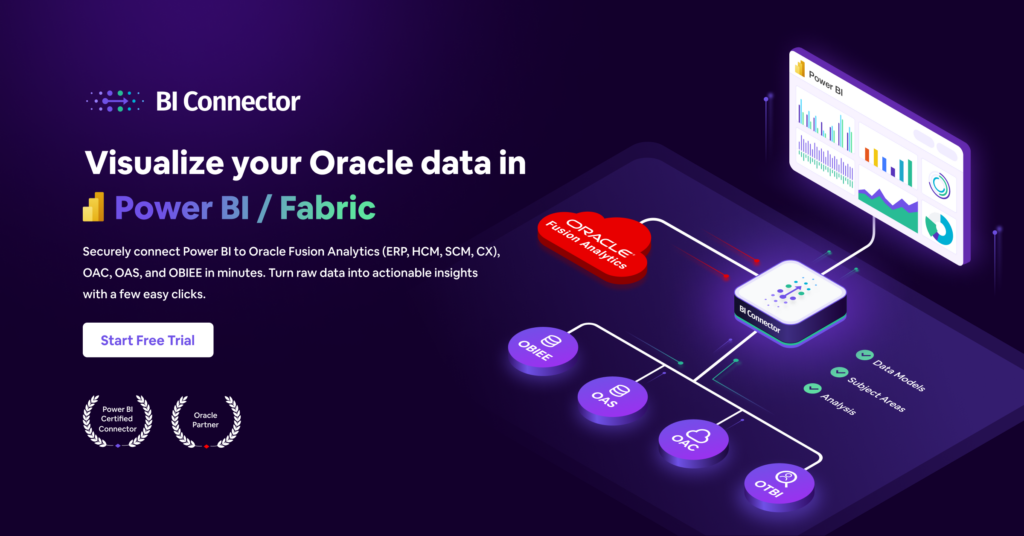Business Intelligence Cloud Connector: 5 Key Considerations to Unlock Insights
Introduction
Oracle Fusion Enterprise Resource Planning (ERP), Supply Chain Management (SCM), Human Capital Management (HCM), and Customer Experience (CX) applications are great for enterprises to streamline their entire business operations.
Collectively known as the Fusion applications, they also incorporate a massive reporting module, Oracle Transactional Business Intelligence (OTBI).
While OTBI is great for reporting Fusion Cloud data, users have to be tech-savvy to fully utilize its data visualization capabilities. Owing to this, many prefer user-friendly data visualization tools such as Power BI for Business Intelligence (BI).
Here comes another pain point. Power BI has an inbuilt Oracle Database adapter; however, Oracle restricts companies from accessing the underlying Fusion Database for security reasons. Oracle, instead, provides an alternative tool for Fusion Cloud users: Business Intelligence Cloud Connector (BICC).
In this blog, we will explore more about BICC and key considerations for effectively using the tool. Keep reading.
What is Oracle Business Intelligence Cloud Connector?
Oracle Business Intelligence Cloud Connector (BICC) is an Oracle tool used to ingest Oracle Fusion Cloud data to an external storage for BI consumption. It’s available as a part of Oracle Applications Cloud subscription.
BICC comes with numerous features, including ingesting data to storage, scheduling, and automating extracts. However, the tool has some limitations that might prove ineffective for some enterprises. Here are the five critical factors leaders must consider before choosing BICC.
5 Critical Considerations for Using BICC
The 5 considerations for companies planning to use (or currently using) Oracle BICC for ingesting Fusion Cloud ERP, SCM, HCM, and CX applications data into Power BI are:
- Complexities of setup
- Ease of data access
- Data size
- Budgetary implications
- BICC alternative
Now, let’s look at each of them in detail.
Complexities of Setup
A data staging environment to ingest your Oracle Fusion data is a primary requirement for setup. This environment could be the Universal Content Management (UCM) server or an external storage such as SQL Server. So before implementing BICC, you need to set up the staging environment.
This poses a critical question.
Does the staging area have a ready-to-use connector in Power BI?
It’s very important to choose a staging area that’s accessible from Power BI. If that’s not the case, you’re left with a difficult process of moving the data from the staging area to another environment that’s accessible from Power BI.
In essence, it takes a lot of time to even arrive at the starting point.

Ease of Data Access
The next key point is the ease of data access.
Is the connection experience in Power BI as easy as navigating a couple of folders, selecting the tables, and visualizing data?
This is not the case with BICC, as Oracle provides access to Public View Objects (PVO) for BICC users.
The good thing is Oracle provides companies with a list of seeded PVOs. The user must find the required column and the PVO where it resides.
Further, when it comes to custom fields, you must ensure they are BI-enabled first. The access to such columns is restricted by default. This restriction must be removed before you start ingesting data to the staging area via BICC.
Data Size
When using BICC, the size of the data ingested could have a huge impact on performance.
One of the BI Connector users had to wait for hours to ingest 576k rows, which amounted to 400MB of memory!
It’s clear that the higher the size of the data ingested, the lower the performance experienced.
To tackle this issue, you can use the BICC’s incremental extracts option.
In the incremental extract experience, the first extract is expected to take a significantly longer time compared to the subsequent incremental extracts. This option comes in handy only for companies that have a need to analyze well-modeled data that requires changes extremely rarely.
However, companies often deal with a BI dataset that keeps changing from time to time.
Budgetary Implications
If you’re using an external storage such as a SQL Server as your staging area, an additional cost is involved for maintaining the database (which is most likely based on the amount of data ingested).
BICC Alternative
A question to ponder.
What if you’re unaware of a tool that connects Power BI directly to Oracle Fusion data?
Yes, there’s an alternative path to BICC when it comes to tackling the need to report Oracle Fusion data in Power BI.
BI Connector, a Power BI-certified solution, connects both Power BI Desktop and Service straight to your Oracle Fusion Data Models.
All you have to do is create a data model in OTBI and connect directly to it from Power BI.
If you have Power BI Desktop in your machine and an OTBI data model in your Oracle Fusion environment, you’re literally just 2 or 3 minutes away from connecting both worlds.
BI Connector comes up with a number of robust features, including shorter wait times and ease of use. It takes just an hour to implement at an enterprise scale and also performs much faster than BICC, especially when dealing with a huge data size.
It does come at an additional cost. However, the amount is far less than the potential cost of using external storage for ingesting data while enabling your entire organization to visualize Oracle data in Power BI!
Further, you can use BI Connector as an ETL tool in Power BI Fabric to create a Lakehouse out of a dataflow!
Click the banner to learn more.
Conclusion
BICC is a robust tool from Oracle to help users ingest Oracle Fusion Cloud data to external storage for data visualization. We discussed five critical factors enterprises should consider when determining the use of BICC for data visualization in Power BI. This includes complexities of setup, ease of data access, data size, budgetary implications, and BICC alternatives.